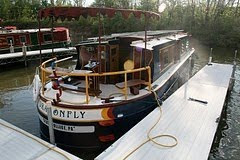 |
| Town wall in Fort Edward. Can you spot the canal boat? |
- Whitehall, where the kind marina owner opened the bar (closed on a Monday) so we could cool off on a scorching day (Thanks, Lynn!)
- Fort Ann, where we investigated an old lock
- Fort Edward, where we docked on the lovely town wall (right)
- Schuylerville, where we enjoyed a visit from the McKay family. Check our "Visitors" page and plan YOUR visit!)
- Mechanicville, for a "make and mend" day.
Sure enough, one of those trademark blue-and-yellow canal authority tugs was backing and filling in the channel ahead of us, manipulating a dredging pipeline.
We maneuvered cautiously behind it and continued down the channel.
Another barge supported what looked like an oversized shipping container, painted bright cobalt blue. We assume was a bunkhouse or other support structure for the workers.
 |
| Water get extracted from the dredged material and returned to the river. |
More Dredging Ahead?
We believe this dredging effort was simply to maintain the depth of the navigation channel. But some wrangling between New York State and the federal government could result in resumed dredging to remove a carcinogen from Hudson River sediments.
PCBs in the Hudson
This stretch of the Hudson River, above Albany, looks placid and pastoral. We haven't passed many factories, and we certainly haven't seen obvious pollutants gushing into the river.
But in 1984, the EPA declared the river—from just above Fort Edward to New York City--a SuperFund Site. Pollution from multiple sources contributed to this drastic designation but one of the biggest contributors was GE. Between 1947 and 1977, its transformer factories in Fort Edwards and Hudson Falls--discharged (by most estimates) 1.3 million pounds of polychlorinated biphenyls (PCBs) into the river.
These chemicals (which are banned from use these days) can cause a discouraging array of medical problems:
neurological disorders, hormonal disruptions, depressed immune system, a
variety of cancers, and more. Over the
past decades, the discharged PCBs didn’t sit there, inert, on the river bottom.
They worked their way up the food chain (fro what to what), getting=ng more
concentrated in organisms higher up the chain.
When we docked at Schuylerville, a little boy on the boat
next to us was gleefully pulling sunfish out of the river . . . and his
grandfather would take them off the line and toss them back in. Every boat
launch and dock you can see signs warning you not to eat the fish you catch.
There’s risk not just from eating fish but from drinking the
water, or breathing the air near a heavily contaminated river.
For wildlife (what can PCBs do to them?)
The good news is that after years of extensive—and
expensive—remediation, the EPA declared a successful cleanup. There were cleanup efforts in 1977-78, in
1991, then the 2009 and 2011-2015. Mostly paid for by GE. (How much did it
cost?) 1.6 billion
The cleanup is considered
one of the largest and most complex environmental dredging projects ever
conducted in the United States.







I was in school in Oneonta in the early '80's when the governor cheerfully announced that he would drink a glass of water with PCBs in it to prove they weren't bad for you!
ReplyDelete